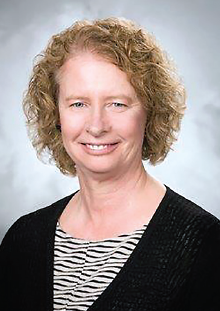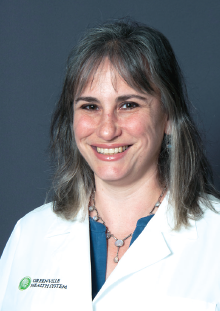Advanced Training in Collaborative Care Offered in APA Online Program
Abstract
Three psychiatrists are using the training they received in the Collaborative Care Model through APA’s online learning collaboratives to expand the reach of psychiatry to primary care patients in their local communities.
If integrated care is the future, then APA members Eve Fields, M.D., Rachel Weir, M.D., and Patricia Ryan, M.D., are on the cutting edge of a trend.

Patricia Ryan, M.D., hopes the learning collaborative can be an ongoing forum to extend collaborative care to pediatric and specialty populations.
They are among some 20 APA members who are participating in or have completed one of APA’s Online Learning Collaboratives, an advanced stage in APA’s efforts to train psychiatrists in the Collaborative Care Model (CoCM) as part of the federal government’s Transforming Clinical Practice Initiative. Online learning collaboratives are more applied training offered by APA for members who have completed introductory training modules in CoCM (see box for a description of the TCPI and the online learning collaboratives).
“I first attended the in-person training a few years ago, at the APA annual meeting,” Patricia Ryan, M.D., told Psychiatric News. “I found the experience quite useful, and the presenters outlined useful strategies for implementation of the model and some of the pitfalls to watch for. It was helpful to meet other psychiatrists from around the country who were interested in this program.
“The online learning collaborative has been a mixture of reading material and conference calls with the moderator and participants,” she said. “While the participants are at varying stages of development of the model, it has been quite helpful to discuss our shared and unique experiences. We plan to continue our collaboration, and some of us are going to meet at the APA meeting this May in San Diego. As we continue our work together, I hope to learn from others’ experiences as they implement these models—both the successes and the missteps.”

Rachel Weir, M.D., says she believes collaborative care can “improve care for the whole population, not just those who show up in our office.”
Rachel Weir, M.D., an assistant professor of psychiatry at the University of Utah, agreed. “The most important thing is that you are hearing from other people who have the same questions or are dealing with the same system-based obstacles and problems,” she said. “This has always appealed to me. I have been in outpatient psychiatry for over 10 years and have seen so many people who are waiting months for an appointment with a psychiatrist.”
Weir is supervising residents who are doing a rotation in mental health integration. “We have nine community primary clinics,” she said. “Each one has a psychiatry resident one day a week who works with the primary care provider and sees patients. When I started supervising, I looked around for resources and learned about the APA training.”
She said the online collaborative has advanced her understanding of CoCM beyond what she could absorb from didactic lectures and helped her apply the didactic training to “real-world” problems. “It’s been a very positive experience, and I am hopeful that by providing this training, it will get psychiatrists to think about how we can do things differently to improve care for the whole population, not just those who show up in our office.”
Her remarks were echoed by Eve Fields, M.D., director of integrated medical services in the Greenville Health System in Greenville, S.C. “I’ve always been interested in the interface between medicine and psychiatry,” she said. “This seemed like the perfect way to address that interest.”
Fields had spent eight years working in community mental health in Fairfax, Va., and came to the APA training with some working knowledge about how integration works. “Lots of my patients had serious and persistent mental illness and comorbid medical conditions,” she said. “We practiced a lot of reverse collaboration, and primary care clinicians were brought into our clinics.”

Eve Fields, M.D., hopes to bring collaborative services to the primary care sites that are part of Greenville Health System.
She then moved on to the Greenville Health System. “Since we cover such a large region with 45 primary care practices, we have nowhere near the number of psychiatrists necessary to meet the need,” Fields said. “I have been working with my chair to start providing collaborative services to these primary care sites so we can leverage the services we do have.”
Participants in an online learning collaborative are expected to complete a performance-in-practice quality improvement project (for which they receive Part II and Part IV Maintenance of Certification credit as well as CME). As part of her collaborative, Fields surveyed colleagues in her system about whether primary care patients were being regularly screened with the PHQ-9—an inquiry that helped uncover workflow problems that could be addressed to improve rates of screening.
All three psychiatrists agreed the APA training is a way to diversify their practice and to address underserved mental health needs in primary care.
“After working almost 30 years as an outpatient, private-practice psychiatrist in Ann Arbor, Mich., I was looking to do something different and had become interested in teaching,” Patricia Ryan, M.D., told Psychiatric News. “I attended a four-day workshop at the Alan Alda Center for Communicating Science at Stony Brook University and was looking for ways to use the skills I had learned. I heard about the Collaborative Care Model and researched the materials available through the University of Washington. I was intrigued with the possibility of teaching both primary care providers and behavioral health care managers.
“I saw this model as a way of helping the primary care providers in my area,” she continued. “I knew they were struggling with the large number of behavioral health issues they were seeing in their patients who had limited access to treatment. This model was an innovative way, I felt, to help patients with uncomplicated depression and anxiety who did not have access to traditional psychiatric services. I also thought I would enjoy working on a team with other behavioral health providers directly in a primary care setting.”
Ryan is bringing the training she received from APA back to her community in ways that are reaping real benefits for patients. “At the same time I was exploring this model, IHA, a large, multispecialty physician organization located in and around Ann Arbor, Mich., and serving over 400,000 patients, was trying to figure out the best way to help their primary care providers with their patients’ behavioral health needs,” Ryan said.
She was hired as the medical director and consulting psychiatrist at IHA for a new collaborative care program and formed a partnership with the existing collaborative care program at the University of Michigan.
“We are in four, soon to be five, primary care practices and are looking at hiring a second psychiatrist to work with us,” Ryan said. “To date, we have enrolled 362 patients and are seeing significant decreases in their depression and anxiety symptoms. … This model is a way to provide expertise to our patients that need behavioral health services but cannot access them and can free up more of our resources for our more complicated patients.” ■
More information about the Transforming Clinical Practice Initiative Support and Alignment Network can be accessed here.



